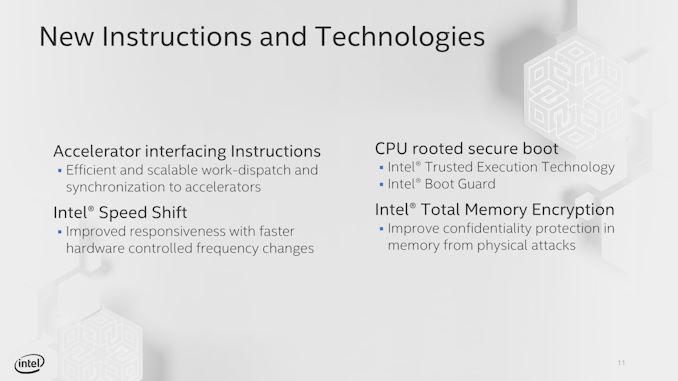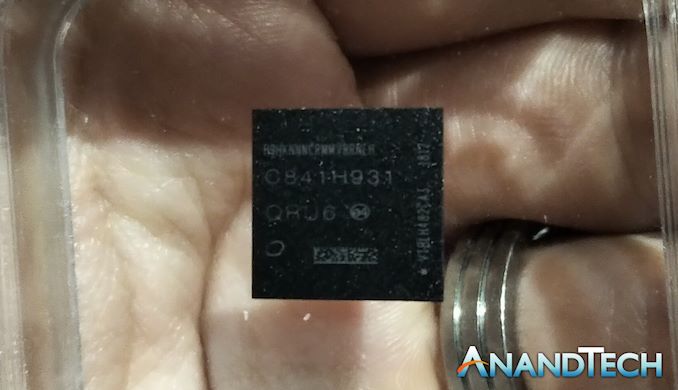Intel's new Atom Microarchitecture: The Tremont Core in Lakefield
by Dr. Ian Cutress on October 24, 2019 1:30 PM ESTBeyond the Core
Nominally today’s disclosure is more about the Tremont microarchitecture than any SoC it might appear in, like Lakefield or Snow Ridge. To that end, Intel wasn’t talking about GPU support (Lakefield will have Gen11 graphics), but Intel did discuss that Tremont would be the first Atom design to fully support Intel’s Speed Shift / ACPI hardware flags, allowing for faster ramp-up and ramp-down of high-frequency operation.
Intel also stated that Tremont supports Total Memory Encryption to prevent physical attacks, Rooted Secure Boot and Boot Guard, and specific accelerator interfacing instructions. With respect to Spectre, Meltdown, and L1TF, Intel stated that Tremont will have the same protections as Cascade Lake.
We also asked Intel about module-level voltage and power control. We were told that within a quad-core module with four Tremont cores, all the cores share the same frequency plane, but each core can enter separate c-states to reduce power consumption when not in use.
Final Thoughts and Slide Deck
In the past, at least from my perspective, dealing with Atom platforms has been amusing. Atom devices typically work great for hyper-focused and optimized software that can take advantage of a latency-insensitive workload, such as networking equipment or a NAS, but for any general purpose use I find them incredibly slow. Perhaps I’m just too used to the big cores on the devices I use – but with Intel saying that Atom is being refocused on performance, it will be interesting to see how Tremont devices and other Core devices will overlap. This graph from Intel is very striking, and if you squint, it looks a lot like some of the smartphone power/performance graphs we’ve produced in the past.
With Intel moving Core down in power to the 1.5W level, again it will be interesting to see how Tremont can play in that 2mW to 2W range that Atom has traditionally played in. The last generation Goldmont Plus devices were going beyond that, and in this power range we also have smartphone cores coming into play. After showing the slide deck to Andrei, we were discussing how a Tremont might stack up against an Arm Cortex A76, or a Kryo core. When we can get our hands on Tremont, we’ll see how they compare. When it comes to the products that Tremont is aiming for however, it still has that x86 advantage.
We did ask a few questions from Intel that we didn’t get answers to, such as die size and target frequencies. The other question to discuss is Intel’s current high-demand issues putting pressure on its manufacturing technologies. Tremont is still a low cost, low powered core, so logic may dictate that it will be a while before we see consumer chips enter the market. Ultimately Intel’s high-demand issues are around 14nm, and so far we’ve only seen Tremont discussed on Intel’s 10+ process with Lakefield and Snow Ridge. What we know about Intel’s 10nm/10+ capacity isn’t a lot, but reports vary from yields being ‘on track’ to ‘working with key OEM partners only’. Intel’s driver for 10+ right now is Ice Lake, which is coming to some premium notebook designs this year, and Lakefield has been announced for the Surface Neo. It is not known what the expected volume for the Neo will be, but it is unlikely to be large. Whether or not Tremont will see the light of day in traditional Atom Celeron and Pentium processors is another question entirely – the Goldmont Atom families have suffered while Intel’s 14nm efforts are more focused on enterprise hardware that can be sold for a much higher $$ per square millimeter. Beyond Lakefield, we might not actually see Tremont in any other consumer chip before the next generation Atom if Intel cannot get its issues sorted.
As and when we get a Lakefield device, we will put it through our tests. Stay tuned.













101 Comments
View All Comments
Valantar - Friday, October 25, 2019 - link
Intel doesn't use the Atom name any longer, at least not officially. Is it anywhere in this slide deck? As for Pentium/Celeron, P/C Silver is Atom-based, Gold is Core, and that applies even to the newest product stack (Intel even launched updated Goldmont Plus Gemini Lake Pentium/Celeron chips just a few days ago, topping out with the J5040 and N5030: https://www.techpowerup.com/260374/intel-gemini-la... Confusing? Absolutely. But nothing has changed since the (admittedly stupid) gold/silver branding was introduced.levizx - Sunday, October 27, 2019 - link
Maybe get your eyes checked? This while article is about the Tremont uArch, so are the slides.Gemini Lake is old news, doesn't matter what "new" product Intel releases. Intel had Atom on their roadmap as late as last December.
BUT, their May investor meeting failed to disclose what brands Lakefield will be under. So as far as the general public know. Atom is still alive in ultra low-power Server SoC and embedded SoC space.
eddman - Sunday, October 27, 2019 - link
There hasn't been an atom branded mainstream (desktop, laptop or tablet) processor strarting with goldmont; only server, embedded and automotive parts, and starting with goldmont plus there is none whatsoever.eddman - Sunday, October 27, 2019 - link
*No edit function*What I meant to say is, while atom branding is not dead, intel has moved away from using it for the products facing the mainstream consumers. It's all pentium and celeron.
I doubt they'd bring it back for lakefield, which even uses a single "big" sunny cove core.
eek2121 - Monday, October 28, 2019 - link
Not true, Apollo Lake showed up in an SBC form factor. That is goldmont + gen9 iGPU.eek2121 - Monday, October 28, 2019 - link
Gah anandtech needs to join the year 2000 and add an edit button. The atom CPU I have seen used is the atom e3900. Yes it is technically an embedded part, but it is also used by consumers for various projects, including home theater applications and the like.eddman - Monday, October 28, 2019 - link
Such devices are not mainstream.Namisecond - Friday, November 1, 2019 - link
You're talking the uarch. The person you're talking to is talking about the Atom brand name.rrinker - Thursday, October 24, 2019 - link
Depends on what you use them for. I have a box I built at least 7 years ago, so whatever Atom was current - I think it was the first one to have 2 cores. I ran Linux on it, mostly for controlling my model railroad. It was plenty fast enough, even with a slow hard drive and just 2GB RAM. I couldn't stream video to it, but music was fine, and it ran both the control program as well as a 2D CAD program to design track plans.Not every task a computer does requires insane speeds. There's a whole lot more than just gaming.
1_rick - Thursday, October 24, 2019 - link
They're good enough for things like NASes.